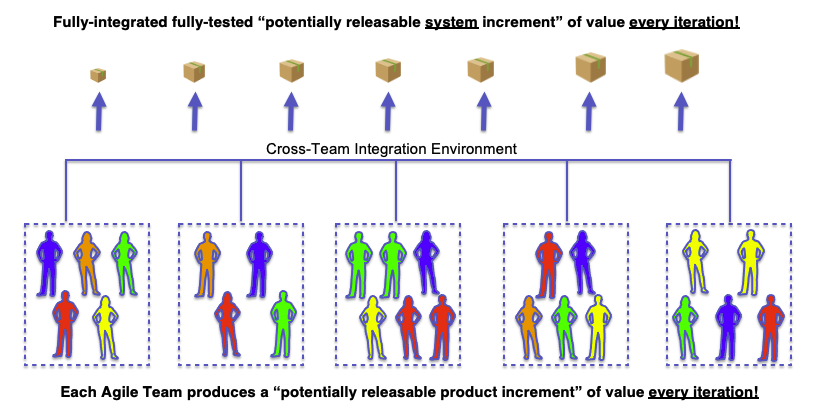For those of you considering an Agile transformation, here is my advice on your #1 consideration. Ask yourself this question:
“Is my organization willing to align to value with cross-functional teams?”
The question is about your willingness to realign your organization to value. In my opinion, all other considerations are secondary and pale in comparison to this one.
Let’s unpack the question a bit.
Alignment to Value
When we receive a customer request, we want our solution to be delivered as fast and efficiently as possible. We want our flow of work to be smooth with minimal or no handoffs, as these typically involve delays. If we can organize our teams around this flow of value, then we can decrease time to market, reduce expenses, and increase customer satisfaction.
Value stream mapping is a well-known Lean technique for determining the steps, systems, and teams involved in delivering a continuous flow of value to the customer. This is a crucial step in any Agile transformation and should be performed up front.
SAFe recommends the formation of Agile Release Trains (ARTs) specifically for the purpose of incremental solution delivery. ARTs are aligned to a value stream and consist of multiple teams working closely together on the same product or service.

Organizations aligned to value have tremendous benefits over those that are not, including speed, higher collaboration levels, lower costs, and common purpose.
Cross-Functional Teams
Agile teams must be cross-functional. Cross-functional means that an Agile team has every technical expertise needed to create a small, valuable product increment within a short period of time. This product increment can be released into a production environment for customer feedback.
Teams that are formed around component expertise (instead of cross-functional) cannot provide value until their output is integrated into the larger system. But it’s not about output, it’s about outcomes! The best outcome is a small product increment that can be released!
To position teams to deliver product increments, we must reorganize our teams to include expertise across all technology domains needed for the product increment. This will allow each team to work vertical slices of functionality (user stories) and easily aggregate them into a releasable product increment.

Cross-functional Agile teams delivering product increments at the team-level are well positioned to scale up into multi-team structures where all team-level increments are integrated into a system increment.
But It’s Hard!
That’s right. It is hard. It requires C-level support and a willingness to reorganize existing hierarchies and silos. If your goal is significant change that increases your company’s chance of survival in a fast-paced world, then do the hard work not the easy work.
SAFe proposes a “dual operating system” where value-aligned teaming constructs are formed virtually with no real change to the reporting hierarchies. In my opinion, this is simply a façade to doing the hard work of truly aligning to value. It’s like playing the game of football and punting on 3rd-down every time we have the ball.
The Bottom Line
If you are not willing to start with alignment to value with cross-functional teams, then my advice is don’t go Agile. You will likely spend millions of $$$ for some decent productivity gains at the team and program level. However, your results will be nothing near the substantial returns you are looking for! There are plenty of consultants and coaches that will take your money, do their best to implement some good improvements, launch trains, facilitate PI Planning sessions, and promise that alignment to value will “eventually” happen.
It won’t.
You will wake up three years from now and realize that not much has really changed. We still struggle with releasing. Our product is still buggy. We still seem slow. The company is on a downward trajectory to irrelevance. Eventually we will run out of patience, run out of funding, a leadership change will be made, or a transformation course redirection will be made. Another failed Agile transformation.
Why not be courageous and implement the single most impactful change that needs to be made? Align to value with cross-functional teams!
For more on SAFe, visit here. For more on what all is typically involved in an Agile transformation, visit here.
